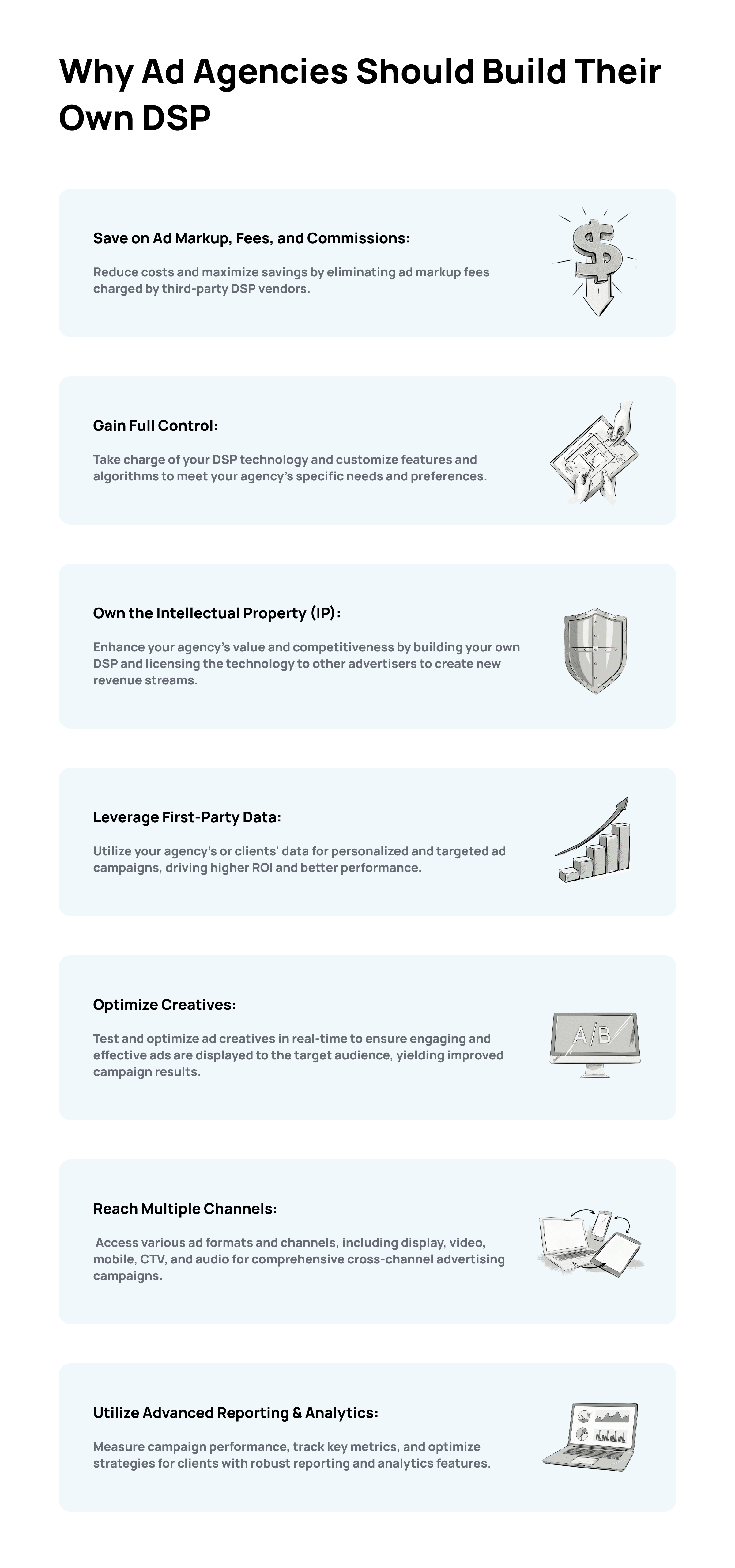It’s no secret that the rise in technology-driven processes like real-time bidding (RTB) has changed the landscape of the online advertising ecosystem. Advertising technology (AdTech) companies have created a range of innovative technologies and algorithms that now make it possible for brands to bypass the advertising agency and enjoy lower costs, higher returns on investments, and more direct audience targeting than what is currently on offer from ad agencies.
One way ad agencies can help buck this trend and retain their clients (i.e., brands) is by building their own demand-side platform (DSP).
Key Points
- A demand-side platform (DSP) is an AdTech platform that allows brands and ad agencies to programmatically buy ad impressions from publishers in a simple and optimized manner.
- DSPs enable precise ad impression evaluation and bidding based on set criteria, improving ad relevance and campaign performance.
- DSPs integrate with ad exchanges, SSPs, DMPs, and e-commerce platforms to access ad inventory, enhance targeting capabilities, and leverage data for advertising campaigns.
- Building a DSP allows agencies to save on ad markup, gain complete control over the technology and product roadmap, and own intellectual property.
- Agencies need to consider the financial advantages, media budget, ongoing costs, and technical skills when deciding whether to rent or build a DSP.
- Effective utilization of DSPs enhances ad campaigns, ensures that they reach the right audiences, and achieves better ROI for ad agencies and their clients.
Why Is a Demand-Side Platform Important for an Ad Agency?
A demand-side platform (DSP) is an AdTech platform that allows ad agencies to buy ad impressions from publishers via supply-side platforms (SSPs) and ad exchanges. DSPs are critical if an ad agency wants to streamline and optimize its ad buying processes.

DSPs automate the process of ad buying, making it faster, cheaper, and more efficient. Instead of manually contacting numerous publishers, DSPs enable agencies to purchase advertising inventory at scale across various channels (e.g., display, video, mobile, search, and CTV) from a wide range of publishers in real-time.
A key component of a DSP is a bidder, which is a mechanism built into the DSP that automates the evaluation of ad impressions and bidding in real-time based on the criteria set by an agency. These criteria can include target audience, budget, and campaign objectives. This enables the ad agency to deliver ad impressions to the right audience, improving ad relevance and campaign performance.
What Agencies Need to Know about DSPs?
In order to navigate the world of DSPs effectively, agencies must first understand the key aspects of these platforms.
What Other Platforms Integrate with DSP?
To work correctly, a DSP must integrate with other platforms. These include:
- Ad exchanges: This integration enables the DSP to access a wide range of ad inventory from various publishers. Ad exchanges pass on bids from SSPs to multiple DSPs, allowing advertisers to evaluate each impression and bid on it accordingly.
- SSPs: This integration enables publishers to offer their inventory to multiple DSPs via ad exchanges.
- Data management platforms (DMPs): This integration enhances targeting capabilities by accessing audiences created in a DMP.
We Can Help You Build a Demand-Side Platform (DSP)
Our AdTech development teams can work with you to design, build, and maintain a custom-built demand-side platform (DSP) for any programmatic advertising channel.
What Fees Are Charged by DSPs?
Different companies have varying fee structures. Some may charge a minimal monthly fee, while others require a combination of set fees, monthly fees, contract payments, and impression fees, among other possible charges.
The current trend in the industry is to promote transparency in fee structures, and there are movements toward making all fees more visible. Some vendors are working towards providing transparent fee breakdowns, empowering marketers and publishers to make informed decisions about their AdTech supply chain.
However, just a few years ago, the following were the main fee models offered by DSPs:
- Percentage of ad spend: The basic DSP fee model charges a percentage of the ad spend made through the platform. Typically, this percentage falls anywhere between 8% and 15% of the total ad spend. This fee is a standard way for DSPs to generate revenue for their services.
- Managed services fee: In addition to the percentage of ad spend model, DSPs may charge an add-on fee for managed services. This fee covers additional DSP services, such as campaign management, optimization, and support. The managed services fee usually ranges from 10% to 12%.
- Third-party data rev-share: DSPs may charge a revenue share on the third-party data used for targeting in ad campaigns. This fee is typically between 10% and 30% and may be applied when utilizing external data sources for audience targeting.
- Various add-on fees: DSPs may offer specific features or functionalities as add-ons to their standard services. These add-ons could incur additional costs, the specifics of which may vary depending on the DSP.
- Markups on proprietary supply and data: Sometimes, DSPs may have their own curated supply or proprietary data products. They may apply markups on such offerings, impacting the final cost for the advertiser.
- Handling inherent RTB costs: DSPs handle certain RTB costs, such as foreign exchange fees when buying in a different currency or dealing with discrepancies between the buyer’s and seller’s reporting. These costs should be transparently disclosed to the buyer.
Who Sets Up the Ad Campaigns in a Demand-Side Platform?
In a DSP, agencies set up and manage their client’s ad campaigns through a single user interface. The platform can have dedicated modules to upload creatives, set up targeting preferences, define budgets, and choose ad formats for ad campaigns.
Most often, the operator of a DSP is an AdOps specialist — a professional who manages and optimizes ad campaigns. AdOps specialists typically have technical expertise and may be required to work with various tools and technologies such as ad servers, DSPs, SSPs, self-serve ad platforms, analytics, HTML, JavaScript, and various reporting platforms.
Within the DSP, AdOps specialists can test creatives, troubleshoot ad delivery issues, optimize campaign performance, and analyze data and metrics.
What Is a Self-Serve Demand-Side Platform?
Unlike managed-service DSPs, where ad campaigns are managed by the DSP’s AdOps team, a self-serve DSP empowers agencies and advertisers to handle their campaigns directly.
The benefits of using a self-serve DSP include:
- Complete control over the campaign settings, targeting options, and budget distribution, allowing campaigns to be tailored to specific needs and goals.
- Real-time optimization, i.e., adjusting bids and targeting parameters as needed to achieve better results.
- Eliminating the need for third-party ad management and getting the most value for ad spend.
- Accessing detailed reports and analytics, enabling agencies to make informed and data-driven decisions.
Should an Ad Agency Rent Or Build a DSP?
Even though advertising agencies are already offering programmatic buying to their clients, the day will come when most agencies must ask themselves: Should we continue utilizing our existing technology (via renting a DSP), or is it time to take the technology in-house (invest in building a DSP)?
While several factors are involved, the primary decision will come down to which option presents the biggest financial advantage for the agency.
To determine which option offers the most economical value, several areas need to be analyzed, including:
- The agency’s media budget.
- The ongoing costs associated with running a DSP.
- The technical skills required to maintain the platform.
To get a comprehensive breakdown of the main financial aspects of renting or building a DSP, continue reading the ExchangeWire article Should Agencies Acquire or Build a Technology Stack to Remain Competitive?
The Main Reasons Ad Agencies Should Build Their Own DSP
There are a number of reasons an advertising agency might consider building their own DSP, but here are the main ones.

Save On Ad Markup, Fees, And Commissions
Many DSP vendors charge an 8% to 15% markup on the price of media. Building their own DSP allows agencies to save on ad markup, which can save significant costs if their media spend is high.
Control over the Technology
Most DSPs on the market offer a number of features, but the tradeoff for ad agencies is that they’re unable to add in features that they need. By building their own DSP, agencies can build the features they really need and leave out the ones they don’t. They also have full control over the product roadmap and can incorporate their own optimization algorithms.
Ownership of the Intellectual Property
Although this is more of a business benefit, it’s still a reason why many ad agencies choose to build their own DSP. Building your own tech will often increase the value of your company and can give you a competitive advantage.
An agency can have full control over the ad-buying process, including selecting inventory, targeting options, and managing campaigns. With proprietary technology, the agency can differentiate its offerings and provide unique features to advertisers, attracting more clients and staying ahead in the market.
Owning a DSP enables agencies to license their DSP technology to other advertisers, generating additional revenue streams through licensing fees or royalties.
And last but not least, having ownership of the DSP’s IP allows the agency to tailor the platform according to their specific needs and requirements. They can customize features, functionalities, and user interfaces to align with their business strategy.
Key Functionalities to Include in Your DSP
First-Party Data Infrastructure
Ad agencies that want to create more personalized and targeted ad campaigns should include support for the use of first-party data in their custom DSPs. That way, they will be able to execute better performance and higher return on investment (ROI).
Creative Optimization
Custom DSPs with creative optimization capabilities allow ad agencies to test and optimize ad creatives in real-time, ensuring that the most engaging and effective ads are shown to the target audience, ultimately driving better campaign results.
Multichannel Reach
Ad agencies often build DSPs that access various ad formats and channels, including display, video, mobile, in-app, CTV, audio, and more. A DSP with multichannel capabilities allows ad agencies to run comprehensive cross-channel advertising campaigns.
Reporting and Analytics
Reporting and analytics features are crucial for ad agencies to measure campaign performance, track key metrics, and optimize advertising efforts.
The Benefits of Integrating DSPs with DMPs
Agencies can enhance their media buying decisions by leveraging a DMP to access supplementary data sets and insights. The DMP equips the DSP with valuable information like consumer demographics, browsing behavior, purchase history, etc.
This way, DSPs can target more precisely created ad campaigns, reaching the most appropriate audience segments, ad formats, and placements.
DSPs and DMPs can be seamlessly integrated through various methods, including APIs, cookie syncing, and server-to-server integration (S2S).
Clearcode’s Experience with Building DSPs for Advertising Agencies
Over the years, numerous advertising agencies have partnered with us to design and build dozens of DSPs. Below are a couple of key examples of our DSP development projects:
Kanary NEST DSP
We helped in the development and success of Kanary NEST DSP, a data-driven demand-side platform for programmatic media buying.
Clearcode tackled the challenges of building a fault-tolerant, scalable platform that optimizes user experience while providing transparency and easy-to-understand reporting.
The platform handles billions of bid requests in real-time, using a combination of modern technologies like Python, Twisted, Redis, and Storm for backend development. The frontend was crafted with JavaScript and Knockout JS to create a user-friendly and recognizable brand image.
Clearcode delivered a successful project that gained recognition, including being featured in TechCrunch Disrupt 2013, ultimately leading to the acquisition of Kanary NEST by Gravity4 in August 2014.
SITO Mobile DSP
SITO Mobile partnered with Clearcode to build a DSP that facilitates location-based mobile advertising campaigns for major brands. Facing several challenges, we managed to:
- Expand inventory access: Clearcode integrated the SITO Mobile DSP with multiple ad exchanges and supply-side platforms, enabling it to tap into a broader inventory. This integration boosted the DSP’s capacity to serve over 40 million impressions daily.
- Optimize infrastructure: Clearcode optimized the DSP’s infrastructure by deploying Amazon Web Services (AWS) components like Amazon RDS, EC2, DynamoDB, and Lambda. This resulted in increased bidding request capacity, reduced manual tasks, efficient frequency capping, rapid instance management, and enhanced campaign reporting.
- Reduce discrepancies: By collaborating with ad exchanges and SSPs, Clearcode built custom reporting mechanisms that significantly reduced discrepancies between impressions and media costs. The disparities, once close to 50%, were brought down to around 1%, leading to improved media spend efficiency.
- Enhance stability and monitoring: Clearcode ensured the platform’s stability and uptime by offering 24/7 monitoring and a service-level agreement (SLA). This proactive approach allowed for immediate responses to performance issues, regular infrastructure optimizations, and overall platform stability.
Our experience in AdTech development enabled us to understand the project’s technical and business requirements.
Clearcode’s development teams, composed of experts in various fields, ensured the smooth execution of the project. Our agile approach allowed for continuous improvement through bi-weekly feature testing and immediate implementation of client feedback.
Summary
A demand-side platform is a fundamental tool for ad agencies that want to automate ad buying, implement advanced targeting strategies, increase their reach, participate in real-time bidding, make data-driven decisions, and leverage programmatic advertising. By building a custom DSP, ad agencies can enhance their ad campaigns, reach the right audiences, and achieve better ROI for their clients.
We Can Help You Build a Demand-Side Platform (DSP)
Our AdTech development teams can work with you to design, build, and maintain a custom-built demand-side platform (DSP) for any programmatic advertising channel.







